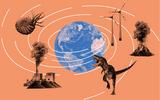MEK – K4 T1 A1 – Curse of the past
300 million years ago, Europe was completely covered by swamp forests. Plants such as horsetails and clubmosses grew to a great height, supplying the raw material for vast coal deposits.
Today, the burning of fossil coal produces enormous amounts of the greenhouse gas carbon dioxide CO2, driving relentless global warming.
No energy source causes more damage to the climate than coal: in 2025, almost 40% of global CO2 emissions still derive from the burning of this fossil fuel.
Together with other fossil energy sources such as oil and natural gas, it accounts for over 90% of global greenhouse gas emissions.
The Bernese Alps. Rock-solid. Immovable. Eternal. But appearances can be deceptive: lying hidden deep within the mountain range are past worlds which shape our present.
In April 2004, during the construction of the Lötschberg base tunnel traversing the Bernese Alps, workers tunnelling through granite came upon coaly shales with plant remains – magnificently preserved evidence of the forests that covered Europe 300 million years ago.
The fossil plant remains from the Alps are not just precious finds documenting the history of the planet. They also have great contemporary relevance: coal from the past threatens our world today.
2025: the vast coal beds from the Carboniferous period are still being mined in many parts of the world, especially in China, India and the US.
In Australia, Kazakhstan and the US, energy-dense coal can be extracted directly from the Earth’s surface, a method known as opencast mining. This is technically easier and cheaper than underground mining.
And yet the price being paid is incredibly high: huge machines tirelessly excavate layer after layer, destroying and polluting entire landscapes. But the damage is not confined to the regional level: the gigantic bucket-wheel excavators could also be said to be eroding our future.
